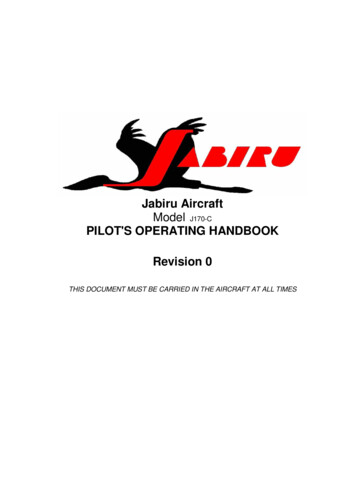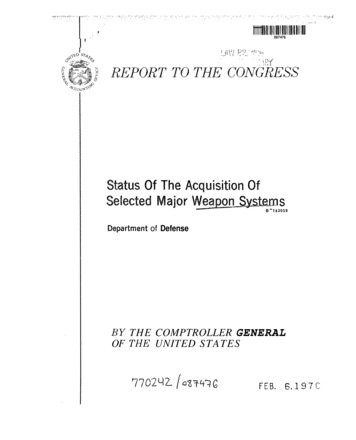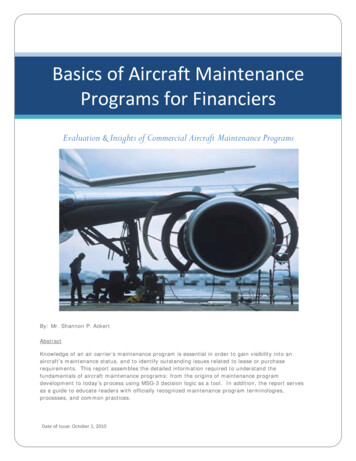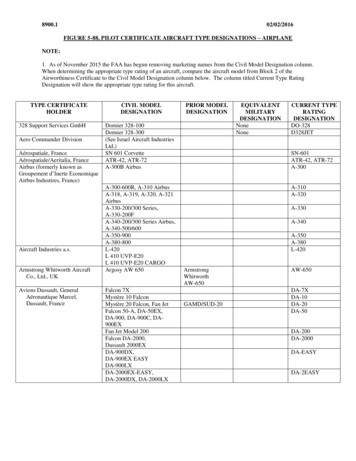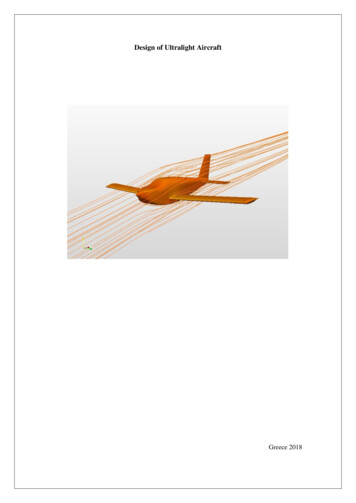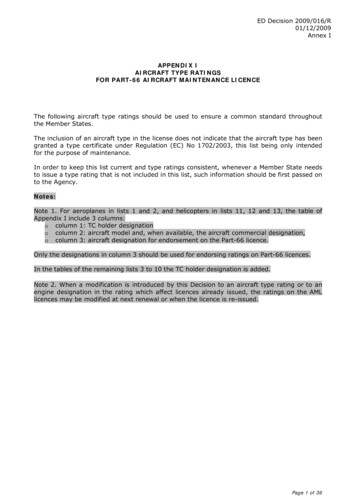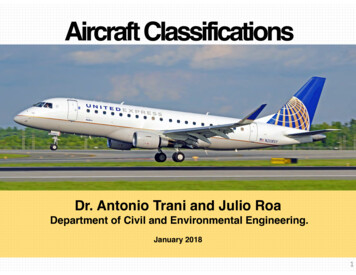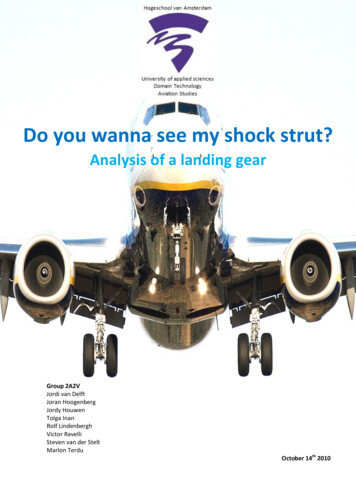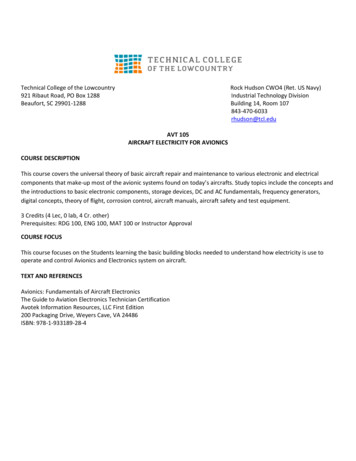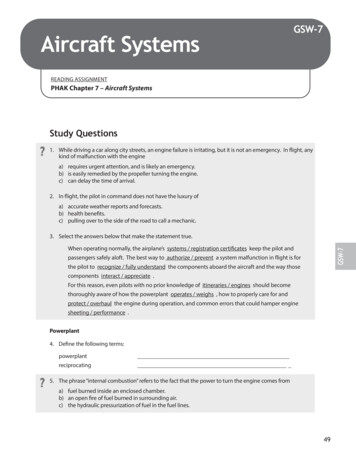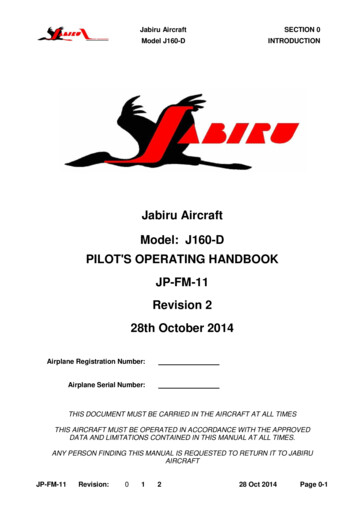
Transcription
Jabiru AircraftSECTION 0Model J160-DINTRODUCTIONJabiru AircraftModel: J160-DPILOT'S OPERATING HANDBOOKJP-FM-11Revision 228th October 2014Airplane Registration Number:Airplane Serial Number:THIS DOCUMENT MUST BE CARRIED IN THE AIRCRAFT AT ALL TIMESTHIS AIRCRAFT MUST BE OPERATED IN ACCORDANCE WITH THE APPROVEDDATA AND LIMITATIONS CONTAINED IN THIS MANUAL AT ALL TIMES.ANY PERSON FINDING THIS MANUAL IS REQUESTED TO RETURN IT TO JABIRUAIRCRAFTJP-FM-11Revision:01228 Oct 2014Page 0-1
Jabiru AircraftSECTION 0Model J160-DINTRODUCTIONRecord of Manual RevisionsThis manual is revised as a complete document. All pages must display the same revisionnumber.Revision Notes:0Initial Issue1Layout revised as per ASTM F2746-122Omissions and Errors correctedMinimum Take-off Oil temp corrected to be 40oC (104oF)JP-FM-11Revision:01228 Oct 2014Page 0-2
Jabiru AircraftSECTION 0Model J160-DINTRODUCTIONTABLE OF CONTENTS0.INTRODUCTION . 0-7PILOT’S OPERATING HANDBOOK . 0-7SUPPORTING DOCUMENTATION . 0-7MANUFACTURER DETAILS . 0-8STANDARDS LIST . 0-8SYMBOLS, ABBREVIATIONS AND TERMINOLOGY . 0-9USE OF METRIC/IMPERIAL UNITS. 0-13WARNINGS, CAUTIONS & NOTES . 0-130.10.20.30.40.50.60.71.GENERAL INFORMATION . 1-141.11.21.31.42.LIGHT SPORT AIRCRAFT NOTIFICATION . 1-14ABOUT THE JABIRU J160-D . 1-15OWNER/OPERATOR RESPONSIBILITES . 1-16J160-D PERFORMANCE & SPECIFICATION SUMMARY . 1-16LIMITATIONS . .EMERGENCY PROCEDURES . 13.4.23.4.33.4.43.4.53.4.63.4.74.GENERAL. 2-17AIRSPEED LIMITATIONS . 2-17ASI Markings: . 2-17AIRCRAFT SERVICE CEILING . 2-18LIMIT LOAD FACTORS . 2-18FLIGHT OPERATION LIMITATIONS. 2-18FUEL . 2-18POWERPLANT LIMITATIONS. 2-18CROSSWIND . 2-19OTHER CLIMATIC RESTRICTIONS . 2-19KINDS OF OPERATION . 2-19POWER GENERATION SYSTEM LIMITATIONS . 2-19OTHER LIMITATIONS . 2-19AIRSPEEDS FOR EMERGENCY OPERATIONS . 3-20CARBURETTOR ICING . 3-21EMERGENCY PROCEDURES CHECK LISTS. 3-22Engine Failures . 3-22Airstart & Limitations . 3-23Forced Landings . 3-24Fires . 3-24Other Emergencies . 3-26Fuel Low Level Warning Light Illuminates (where equipped). 3-28AMPLIFIED EMERGENCY PROCEDURES . 3-30Fuel Gauges / Low Level warning Light (where equipped) . 3-30Engine Failure . 3-30Forced Landings . 3-30Ditching . 3-31Fires . 3-31Rough Engine/Loss of Power . 3-31Electrical Systems Malfunctions. 3-32NORMAL PROCEDURES . 4-33JP-FM-11Revision:01228 Oct 2014Page 0-3
.84.8.95.Jabiru AircraftSECTION 0Model J160-DINTRODUCTIONGENERAL . 4-33SPEEDS FOR NORMAL OPERATION . 4-33BEST ANGLE OF CLIMB SPEED . 4-33BEST RATE OF CLIMB SPEED . 4-33PREFLIGHT INSPECTION . 4-34NORMAL PROCEDURES CHECK LISTS. 4-37Before Starting Engine . 4-37Starting Engine - Cold . 4-37Taxiing . 4-37Before Take-Off. 4-38Take-Off . 4-38Initial Climb . 4-38Cruise. 4-39Descent . 4-39Before Landing (and flight below 1000ft AGL) . 4-39Landing . 4-39Baulked Landing . 4-39After Landing/Securing . 4-39AMPLIFIED PROCEDURES. 4-40Preflight Inspection . 4-40Electric Fuel Gauges (where equipped):. 4-40Starting Engine . 4-40Taxiing . 4-40Engine Management – Ground Running . 4-41Before Take-Off. 4-42Take-Off . 4-42Climb . 4-42Cruise. 4-43Stalls . 4-43Approach and Landing. 4-43Cross Wind Landing. 4-43Baulked Landing . 4-43Flight Over Water . 4-43ADVANCED PROCEDURES . 4-44Short Field Take-Off . 4-44Short Field Landing . 4-45Soft Field Take-Off . 4-45Soft Field Landing. 4-46Crosswind Take-Off . 4-47Crosswind Landing – “Wing Low” Method . 4-47Crosswind Landing – “Crab” Method . 4-48S-Turns. 4-49Side Slips. 4-49PERFORMANCE . 5-505.1GENERAL . 5-505.2APPROVED DATA . 5-515.2.1Airspeed Indicator System Calibration . 5-515.2.2Stall Speeds . 5-525.2.3Take-Off Performance. 5-525.2.4Landing Distances . 5-535.2.5Climb . 5-545.3ADDITIONAL INFORMATION . 5-56JP-FM-11Revision:01228 Oct 2014Page 0-4
5.3.15.3.25.3.35.3.45.3.55.3.66.Jabiru AircraftSECTION 0Model J160-DINTRODUCTIONCruise. . 5-56Endurance . 5-56Balked Landing Climb. 5-57Performance Effects of Dirt / Insects . 5-57Demonstrated Crosswind Performance . 5-57Noise Data . 5-57WEIGHT AND BALANCE INFORMATION . 6-586.1GENERAL. 6-586.1.1Aircraft Weighing Procedures. 6-596.2AIRCRAFT WEIGHT . 6-616.2.1Weight and Balance Record . 6-616.3LOADING SYSTEM . 6-646.3.1Baggage Zones . 6-64Trim Sheet . 6-656.3.2Allowable Loading Conditions . 6-666.3.1Operation Equipment List . 6-676.3.2Baggage Area. 6-726.4CENTRE OF GRAVITY LIMITS . 6-726.5EQUIPMENT LIST . 6-737.DESCRIPTION OF AIRPLANE AND SYSTEMS . 7-767.1INTRODUCTION . 7-767.2THREE-VIEW DRAWING. 7-767.3AIRFRAME . 7-767.4FLIGHT CONTROLS. 7-777.4.1Trim System. 7-777.5INSTRUMENT PANEL . 7-777.6GROUND CONTROL . 7-797.7WING FLAP SYSTEM . 7-797.8UNDERCARRIAGE SYSTEM . 7-797.9SEATS . 7-797.10OCCUPANT RESTRAINT HARNESSES. 7-797.11BAGGAGE SHELF . 7-797.12ENTRANCE DOORS . 7-797.13ENGINE . 7-807.13.1Powerplant Instrument Markings . 7-807.13.2EFIS & EMS LIMITATIONS DISPLAY . 7-807.13.3Engine Controls . 7-807.13.4Engine Instruments. 7-807.13.5Engine Oil System . 7-817.13.6New Engine Break-in and Operation . 7-817.13.7Ignition System . 7-817.13.8Starting System. 7-817.13.9Air Induction System . 7-827.13.10Exhaust System . 7-82Fuel Supply System . 7-827.13.11Cooling System . 7-827.14PROPELLER . 7-827.14.1Jabiru Fixed Pitch Wooden Propeller . 7-827.14.2Jabiru Fixed pitch Composite Scimitar Propeller . 7-837.15FUEL SYSTEM . 7-837.16FUEL ETHANOL CONTENT . 7-85JP-FM-11Revision:01228 Oct 2014Page 0-5
.17.23.27.23.38.SECTION 0Model J160-DINTRODUCTIONBRAKE SYSTEM. 7-85ELECTRICAL SYSTEM . 7-86COCKPIT VENTILATION . 7-89PITOT-STATIC SYSTEM AND INSTRUMENTS . 7-89Airspeed Indicator. 7-89Altimeter . 7-89Vertical Speed Indicator. 7-89STALL WARNING SYSTEM . 7-89AVIONICS . 7-89PLACARDS . 7-90Cockpit Placards General . 7-90Cockpit Controls . 7-93External Fuselage . 7-93HANDLING AND SERVICING . u AircraftINTRODUCTION . 8-95IDENTIFICATION PLATE . 8-95AIRCRAFT DOCUMENTS . 8-95AIRCRAFT INSPECTION, MAINTENANCE & REPAIR. 8-96MANDATORY INSPECTION AND MAINTENANCE . 8-96PREVENTATIVE MAINT. & MINOR FIELD REPAIR . 8-96GROUND HANDLING – TAXIING. 8-97TOWING INSTRUCTIONS . 8-98SECURING THE AIRCRAFT . 8-98TIE-DOWN INSTRUCTIONS . 8-98Control Locks. 8-98Security . 8-98PARKING . 8-98JACKING . 8-99FLUID SERVICING. 8-100APPROVED FUEL GRADES & SPECIFICATIONS. 8-102APPROVED OIL GRADES & SPECIFICATIONS . 8-103Engine Oil Viscosity Grade: . 8-103WHEEL BRAKE SYSTEM . 8-104UNDERCARRIAGE . 8-104TYRES . 8-104INDUCTION AIR FILTER . 8-105BATTERY SERVICE . 8-105ALTERATIONS OR REPAIRS . 8-105LEVELLING. 8-106FLYABLE STORAGE . 8-106CLEANING AND SIMILAR CARE . 8-106Windshield and Windows . 8-106Painted Surfaces . 8-107Propeller Care . 8-107Engine Compartment . 8-107SUPPLEMENTS . 9-1089.1FLIGHT TRAINING SUPPLMENT . 9-1089.2INFORMATION FOR THE OWNER . 9-1089.2.1IMPROVEMENTS OR CORRECTIONS . 9-1089.2.2CONTINUED OPERATIONAL SAFETY REPORTING . 9-1099.2.3OWNER CHANGE OF ADDRESS NOTICE . 9-109JP-FM-11Revision:01228 Oct 2014Page 0-6
9.39.4Jabiru AircraftSECTION 0Model J160-DINTRODUCTIONSUPPLEMENTS . 9-110LOG OF SUPPLEMENTS – JABIRU AIRCRAFT SUPPLEMENTS . 9-1100. INTRODUCTION0.1PILOT’S OPERATING HANDBOOKThe POH handbook consists of the following:Basic POHThe basic POH provides all the information, procedures and limitations required to operate theaircraft as a Light Sport Aircraft. This basic POH is applicable to all Jabiru J160-D Aircraft.The operating procedures presented herein are the result of Jabiru Aircraft’s knowledge andexperience gained up to the date of issue of this handbook. The handbook may be used foroperational purposes only if kept in a fully amended state. It contains all the informationconsidered necessary to safely operate the aircraft.The operator must be thoroughly familiar with the aircraft and the contents of this handbookbefore initial operation. Thereafter the handbook should be reviewed periodically to enable theoperator to maintain the highest level of familiarity with the aircraft, its controls and recommendedoperating procedures.This POH also includes the information required of the Flight Training Supplement: there is noseparate FTS for the J160-D.SupplementsSelf contained supplements are provided in Section 9 of the POH to provide details andprocedures associated with the fitment of specified optional and special purpose equipment.Supplements are specific to the particular aircraft S/No. displayed on their title page.AmendmentsThis manual is revised as a complete document. When a new issue of the manual becomesavailable operators must transfer the aircraft-specific data (such as aircraft weight and balanceinformation and supplements) to the new manual. The old manual must not be used for furtheroperation of the aircraft.Operators must then familiarise themselves with the new revision of the manual. Those sectionsof the manual which have been revised are shown with a vertical line in the right margin.0.2 SUPPORTING DOCUMENTATIONThe following manuals are required for correct operation & maintenance of the Jabiru J160-D.The current revisions are available free of charge from the Jabiru Aircraft websitewww.jabiru.net.au :Pilot’s Operating HandbookAircraft Technical Manual (incorporating Propeller Maintenance Manual)Engine Maintenance ManualEngine Overhaul ManualJP-FM-11Revision:01228 Oct 2014Page 0-7
Jabiru AircraftSECTION 0Model J160-DINTRODUCTIONIn addition, the operator and maintainer must be aware of all current supplemental serviceinformation issued by Jabiru Aircraft – again, the latest revisions are available from the JabiruAircraft website. These documents include:-Service BulletinsLSA Safety DirectivesService LettersFinally, operators and maintainers must be aware of any requirements issued by AirworthinessAuthorities and available from their respective web sites:Airworthiness Directives issued by the Civil Aviation Safety AuthorityRecreational Airworthiness Notice issued by Recreational Aviation Australia0.3 MANUFACTURER DETAILSJabiru Aircraft P/LPO Box 5186Bundaberg West,QLD 4670Phone: 07 4155 1778Fax: 07 4155 2669Email: info@jabiru.net.auStreet Address:Jabiru AircraftAirport Drive, Hinkler AirportBundabergQLD 46700.4 STANDARDS LISTDesign & PerformanceThe Jabiru J160-D has been designed to comply with therequirements of ASTM F2245-13b.Quality AssuranceThe Jabiru J160-D has been constructed under a Quality Systemmeeting the requirements of ASTM F2279-10.Continued AirworthinessThe continued airworthiness of the J160-D is monitored by JabiruAircraft P/L in accordance with the requirements of ASTM F229510.POHThis POH has been prepared to comply with the requirements ofASTM F2746-12JP-FM-11Revision:01228 Oct 2014Page 0-8
Jabiru AircraftSECTION 0Model J160-DINTRODUCTION0.5 SYMBOLS, ABBREVIATIONS AND TERMINOLOGYAAmpereAGLAbove Ground LevelAMSLAbove Mean Sea LevelAVGASAviation GasolineBHPBrake Horse PowerCASACivil Aviation Safety Authority (Australia)CAOCivil Aviation Order (Australia)CARCivil Aviation Regulation (Australia) CDegrees CelsiusCHTCylinder Head
PILOT'S OPERATING HANDBOOK JP-FM-11 Revision 2 28th October 2014 Airplane Registration Number: Airplane Serial Number: THIS DOCUMENT MUST BE CARRIED IN THE AIRCRAFT AT ALL TIMES THIS AIRCRAFT MUST BE OPERATED IN ACCORDANCE WITH THE APPROVED DATA AND LIMITATIONS CONTAINED IN THIS MANUAL AT ALL TIMES. ANY PERSON FINDING THIS MANUAL IS REQUESTED TO RETURN IT TO JABIRU AIRCRAFT . Jabiru Aircraft .

